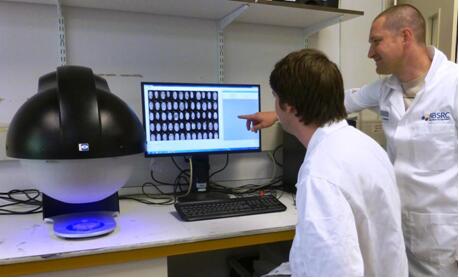品质至上,客户至上,您的满意就是我们的目标
技术文章
当前位置: 首页 > 技术文章
多光谱食品品质可视化:监测戊糖乳杆菌培养物对病原体存活生物保护潜力包装
发表时间:2024-07-31 14:38:58点击:211
来源:北京博普特科技有限公司
分享:
VideometerLab 4采用了LED滤波技术,组合测量可达多达20个不同波长并集成到1张高分辨光谱图像中。图像的每一个像素为反射光谱,设备可涵盖UV、可见光以及NIR波长其集成了可见光RGB高清成像,UV紫外成像以及近红外成像(组分分析)等强大功能。此设备还可选配叶绿素测量模块(叶绿素a和叶绿素b)。
VideometerLab4是一款光谱成像设备,设计用于快速、有效测定表面颜色、质构、化学组分,图像面积可达90 x 90。此设备易于使用,该设备简单易用,集成了照明,相机以及计算机技术,具有先进数字图像分析以及数据统计能力。 该技术对于于对样品或表面的化学和可视特性定性测量特别有用。

该系统也可以对细菌、真菌、虫卵等进行高通量成像测量,进行毒理学或其它研究,用于食品谷物、作物、肉品等等进行精确、全面品质检测。
监测戊糖乳杆菌培养物对病原体存活和在改良气氛下储存的新鲜即食沙拉的保质期的生物保护潜力包装
摘要:
在全球范围内,新鲜蔬菜或最低限度加工的沙拉与几个食源性疾病暴发有关。本文研究了戊糖乳杆菌FMCC-B281细胞(F)及其上清液(S)对鲜切即食沙拉腐败变质的影响以及单核细胞增生李斯特菌和大肠杆菌O157:H7在贮藏过程中对鲜切即食(RTE)沙拉的保质期影响。此外,傅里叶变换红外 (FTIR) 和多光谱成像 (MSI) 分析被用作快速和非破坏性技术来估计样品的微生物状况。本研究采用新鲜长叶莴苣、火箭卷心菜和白菜,接种戊糖乳杆菌和两种病原菌。将菌株分别在 37 ◦C 下在 MRS 和 BHI 肉汤中生长 24 小时,然后离心以收集上清液和沉淀物(细胞)。使用细胞 (F, ~5 log CFU/g)、上清液 (S) 和对照 (C, 肉汤) 喷洒先前被病原体污染(喷洒)的每种新鲜蔬菜的叶子 (3 log CFU/g)。随后,将沙拉包装在气调包装(10%CO2/10%O2/80%N2)下,并在4°C和10°C下储存直至变质。在储存期间,微生物计数和pH值与FTIR和MSI分析同时进行监测。结果表明,在贮藏过程中,莴苣和火箭的病原菌数量增加,与处理无关。对于卷心菜,病原体种群在整个储存过程中保持稳定。在腐败微生物群方面,F样品中的假单胞菌数量较低,而储存在4°C的C、F和S样品中的肠杆菌科和酵母菌/霉菌数量没有差异。根据感官评价,与S和F样品相比,对照样品的保质期较短,而S和F样品的保质期延长了1-2天。三种叶菜的初始pH值约为6.0。在所有叶菜的情况下,在两种温度下,pH值都增加了约0.5值,直到储存结束。FTIR和MSI分析尚不能令人满意地估计沙拉的微生物质量。总之,应用的生物保护菌株(L. pentosus)可以延长即食沙拉的保质期,而不会影响病原体的生长。

关键词:预切沙拉;生物保存;单核细胞增生李斯特菌;大肠杆菌;傅里叶变换红外(FTIR)光谱;多光谱成像 (MSI) 分析
Monitoring the Bioprotective Potential of Lactiplantibacillus pentosus Culture on Pathogen Survival and the Shelf-Life of Fresh Ready-to-Eat Salads Stored under Modifed AtmospherePackaging
Abstract:
Globally, fresh vegetables or minimally processed salads have been implicated in several
foodborne disease outbreaks. This work studied the effect of Lactiplantibacillus pentosus FMCC-B281 cells (F) and its supernatant (S) on spoilage and on the fate of Listeria monocytogenes and Escherichia coli O157:H7 on fresh-cut ready-to-eat (RTE) salads during storage. Also, Fourier transform infrared (FTIR) and multispectral imaging (MSI) analysis were used as rapid and non-destructive techniques to estimate the microbiological status of the samples. Fresh romaine lettuce, rocket cabbage, and white cabbage were used in the present study and were inoculated with L. pentosus and the two pathogens. The strains were grown at 37 ◦C for 24 h in MRS and BHI broths, respectively, and then were centrifuged to collect the supernatant and the pellet (cells). Cells (F, ~5 log CFU/g), the supernatant (S), and a control (C, broth) were used to spray the leaves of each fresh vegetable that had been previously contaminated (sprayed) with the pathogen (3 log CFU/g). Subsequently, the salads were packed under modified atmosphere packaging (10%CO2/10%O2/80%N2 ) and stored at 4 and 10 ◦C until spoilage. During storage, microbiological counts and pH were monitored in parallel with FTIR and MSI analyses. The results showed that during storage, the population of the pathogens increased for lettuce and rocket independent of the treatment. For cabbage, pathogen populations remained stable throughout storage. Regarding the spoilage microbiota, the Pseudomonas population was lower in the F samples, while no differences in the populations of Enterobacteriaceae and yeasts/molds were observed for the C, F, and S samples stored at 4 ◦C. According to sensory evaluation, the shelf-life was shorter for the control samples in contrast to the S and F samples, where their shelf-life was elongated by 1–2 days. Initial pH values were ca. 6.0 for the three leafy vegetables. An increase in the pH of ca. 0.5 values was recorded until the end of storage at both temperatures for all cases of leafy vegetables. FTIR and MSI analyses did not satisfactorily lead to the estimation of the microbiological quality of salads. In conclusion, the applied bioprotective strain (L. pentosus) can elongate the shelf-life of the RTE salads without an effect on pathogen growth.
Keywords: pre-cut salads; biopreservation; Listeria monocytogenes; Escherichia coli; Fourier transform infrared (FTIR) spectroscopy; multispectral imaging (MSI) analysis
相关阅读
丹麦VideometerSLS/SGT颗粒/粘度/口感评价测量仪
食品品质光谱成像可视化:光谱成像应用于面食小麦籽粒真伪检测的可行性研究
食品品质光谱成像可视化:多光谱成像 (MSI):一种检测掺有马肉的碎牛肉的有前景的方法
食品品质光谱成像可视化:色度计和多光谱图像的肉类颜色测量结果的比较
食品品质光谱成像可视化:利用多光谱成像进行非侵入性污染评估和肉类样品绘图
食品品质光谱成像可视化:使用多光谱成像分析快速无损识别注水牛肉样品
食品品质光谱成像可视化:具有不同亚硝酸盐和硝酸盐还原酶活性的肉相关葡萄球菌在发酵香肠中的颜色形成
食品品质光谱可视化研究:长时间低温热处理的奶牛和公牛的肉韧性与结缔组织特性的关系
食品品质光谱成像可视化:使用 vis/NIR 多光谱成像对微加工苹果的每日新鲜度衰减:初步测试
食品品质光谱成像可视化:多光谱视觉系统与色度计在肉色评估中的比较
食品品质光谱可视化研究:使用光谱成像和三色测量对鲑鱼虾青素颜色进行分类
食品品质光谱可视化研究:长时间低温热处理的奶牛和公牛的肉韧性与结缔组织特性的关系
食品品质光谱可视化研究:高通量多光谱图像处理在食品科学中的应用
食品品质光谱可视化研究:一种基于多光谱图像的肉类腐败检测智能决策支持系统
食品品质光谱可视化研究:多光谱成像在草莓果实品质属性和成熟期测定中的应用
食品品质光谱可视化:多光谱成像技术在阿拉比卡和罗布斯塔咖啡豆鉴别中的应用
多光谱食品品质无损检测:用于快速评估鸡肉汉堡微生物质量的光谱数据
多光谱食品品质分析:利用基于光谱学、成像分析和模拟人类感官的传感器技术快速评估食用海藻的微生物质量霉菌种类和代谢物
多光谱食品品质可视化研究:结合DNA条形码、靶向代谢物分析和多光谱成像来识别切片面包中的霉菌种类和代谢物
多光谱食品品质可视化:通过光谱和仿生传感器和数据融合评估腌制鸡肉Souvlaki的微生物破坏和质量
多光谱食品品质可视化:凝乳酪蛋白凝胶性质对马苏里拉干酪挤压结构、流变学和功能性质的影响
多光谱食品品质可视化:基于双道二维相关光谱(2t2d Cos)和多快照可见近红外多光谱成像的牛肉肌肉鉴别新方法
多光谱食品品质可视化:丹麦黄油曲奇的分批与连续面团混合-近红外高光谱成像研究
多光谱食品品质可视化:利用透射多光谱成像技术定量评价椰子油掺假
食品多光谱品质可视化:人工光对整只煮熟的北方对虾冷冻贮藏过程中脂质氧化的影响
Videometer多光谱成像系统食品品质可视化:高油酸葵花籽油作为糖衣中棕榈油的潜在替代品—使用多光谱成像和电子鼻的比较质量测定